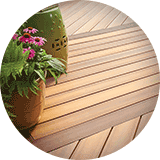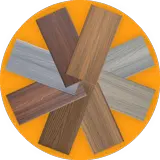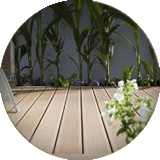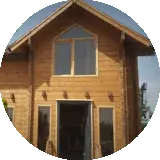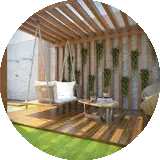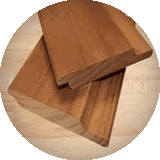about us
Van Wood has a 16-years history in the wood industry and thermowood.
The raw materials of this collection are prepared, classified and supplied from the best selected trees from the taiga forests. using the best machines and the best cutting techniques. thermo wood is prepared and sent to this company. The constructed production line has the best technology in the world in this industry so that the whole system works fully automatically and depends on the type of wood (needle like pine and broad leaf like sparrow tongue (ash)) with different sizes and with different densities for uses. Morever its various applications in (facade, wall, sauna, floor, pool area, Jacuzzi, landscaping and pavilion, columns, doors and windows) with the characteristics of the special process required for self-processing, production with the best quality and very competitive price to the market is offered.

What is thermowood?
To summarize, thermowood actually includes facade wood, floor wood and also structures that will give a special and extraordinary beauty to your environment.
Thermowood is actually the process of drying wood with water vapor and air circulation.
in which the wood kernel reaches a temperature between 185 and 220 degrees Celsius. Depending on the type of wood, its humidity is below 6% and due to the high temperature that enters it, cellulose chains break. Also, during this process, the acid in the wood tissue evaporates then it is removed from any microscopic animals and insects.
History of the emergence of thermo wood in the wood industry
As you know, wood is one of the first and best building materials that humans became familiar with to build a house. Therefore, the history of using wood as a building material has a long history.
It should be noted that although early humans used caves as their primary refuge.
wood was in fact the first building material that humans used to build houses and shelters. However, everyone knows that the physical properties of plain wood place limits the performance, especially outdoors.
A very important point about wood is the fact that burning wood surface in fire will make it more resistant for outdoor use. This fact has been used by humans for centuries. The Vikings, for example, used this method to create exterior structures. Even for the first time, wood heat treatment was studied scientifically in the 1930s.
It should be noted that Finland is a leader in the THERMO WOOD industry. Because it was the first country to acquire its manufacturing technology and create its first production line.
It can be said that the deepest and most comprehensive research work in the field of thermowood has been carried out by the Finnish Thermowood Association (VTT). Today, thermowood is produced using a method developed by the Finnish Thermowood Association. Finally, the thermal treatment process of thermowood or thermowood on an industrial scale was created by the Finnish Thermowood Association in cooperation with its wood products industry, and the thermowood process license was granted to the members of the Finnish Thermowood Association.
What is the process of thermo wood van wood?
To summarize, in the production process of thermowood (thermowood) in addition to protecting wood with steam, the wood is heated to a temperature of 180 to 215 degrees Celsius, which at this stage is said to be processed wood. Water vapor, in addition to its protective role, also affects the chemical changes caused to wood. Therefore, the fruit of this method (ie the same thermowood heat treatment) is a product known as thermowood.It is interesting to know that due to the fact that wood is a natural substance, this product is also a part of nature and is very environmentally friendly.
In general, the process of treating wood to produce thermowood has completely different methods using oil, water vapor… It should be noted that in all these processes, three stages of drying, heating and cooling are performed.
methods
The process of thermo facade wood has various methods in which oil, water vapor, etc. are used. In all these processes, three stages of drying, heating and cooling are performed. The brands that supply outdoor wood are mainly Finnish.
It should be noted that in this process, the color of the wood also becomes slightly darker and in the conditions of changing humidity becomes more balanced than ordinary wood. That is, the color of the wood changes from light white to dark brown. It is worth mentioning that this product is stronger in terms of thermal insulation and is also resistant to rot. Measurements also indicate that the amount of dimensional change in the thermowood is minimal.
In short, in the process of heat treatment, wood with a temperature of about 180 to 215 degrees Celsius with water vapor and air circulation remains in the kiln until the wood kernel reaches the desired temperature. In the following section, we have brought you the steps of this process:
Phase 1: increase the temperature and dry the wood at a relatively high temperature
In the thermowood process, the wood is first cut into different dimensions. In the next step, the temperature of the wood is raised to about 100 degrees Celsius with the help of water vapor and heat. Then gradually raise the temperature to 130 ° C and water vapor is used to prevent cracking of the wood during this process. Of course, it should be noted that water vapor also prevents the occurrence of chemical interactions inside the wood texture, and this role should not be overlooked. At this stage, the moisture content of the wood reaches about zero and the wood dries.
Phase 2: Thermal changes of wood
In this phase, the temperature of the wood increases to about 180 to 215 degrees Celsius and this increase depends entirely on the thermo classification. After the wood temperature reaches the desired temperature, the wood is kept at this temperature for certain time. On the other hand, the presence of water vapor at this stage prevents the wood from catching fire. Of course, it is worth mentioning that in the process of wood processing, oxygen is also removed from the environment, and this makes it impossible to burn wood. It should be noted that at this stage, the gum and moisture of the wood is completely removed and all parts of the wood to its center becomes light brown.
Phase 3: Moisturizing the wood
In this phase, with the method of tropical rain and sprinkling water on the wood, the temperature of the wood is gradually reduced until the wood finally reaches the desired moisture balance properties.The result will be wood with a moisture content of about 4 to 6 percent.
Chemically, we must say that during the thermo process, due to the use of relatively high heat, hemicelluloses or the same sugar chains are broken and its acids are decomposed. The result is that the final product or the final processed wood is completely natural and free of any chemicals.In addition, due to the release of food from the wood, other wood-eating insects are no longer inclined to these woods.
At this stage, most of the wood resin is removed and the remaining part is crystallized and harmed.Finally, the wood obtained is resistant to heat, cold, moisture, rain, insects as well as any deformation in indoor and outdoor environments.

Types of thermo wood
Thermowood is categorized in several ways, and here we have tried to summarize these types for you dear ones:
A) Types of thermo wood in terms of production method
The first and most common division for thermowood is the thermowood production method. In this classification method, thermowood is divided into two classes.In the discussion of standard classification for thermowood processing or treatment, there are two types of classification, which are: Thermo-S and Thermo-D
In the following section, we will explain the difference between these two types for you Van Wood customers:
Type 1: Thermo-S
It should be noted that in this classification, S actually stands for Stability, meaning stability. This means that in the thermowood process, dimensional stability is the most important and key feature of this product in end applications.
In this method, the wood is heated to a temperature of 180 ° C and its strength increases. The resulting thermowood is usually used for indoor environments due to its dimensional stability.
It should be noted that the products obtained from this method will have something between 6 to 8% depending on the humidity, dimensional changes or swelling.For this reason, the needle species of these products for use in the internal components of the building, including indoor furniture, fittings in dry environment, door and window components, saunas, as well as its broad-leaved species for fittings in any climate, flooring, furniture,Green space furniture and sauna are used.
Type 2: Thermo-D
In this type, D stands for durability.This means that in the production process of this type of thermowood, the issue of natural durability of this product is raised as the key of the most important feature.
In this method, the wood is heated to a temperature of 220 degrees Celsius and its strength increases against all atmospheric factors.This method of treatment makes the product obtained from this method extremely durable, so it is very suitable for use in outdoor environments and open areas.
It should be noted that the products of this method will vary in size or swelling by about 5 to 6% depending on the humidity of the environment and different temperature conditions.That is why the products obtained for use in exterior doors, facades and walls, saunas, behind windows, bathrooms, green space furniture and flooring and broadleaf species for all similar uses of type S in dark colors.More are recommended.
B) Types of thermowood in terms of wood species
Thermowood is divided into the following two categories in terms of type and species of wood.
Softwood: Softwood is mainly found in conifers such as pine.
Hardwood: Hardwood is mainly found in broadleaf trees such as sparrows.
Do not forget that in our country, the species of softwood is mainly pine (pine) and hardwood is often the tongue of sparrow (Ash). Pine thermo wood is mainly used in building facades and vertical walls,however, Ash thermowood is also used in floors, landscaping, urban furniture floors, etc. in areas that need relatively more resistance.
Wpc.ir
C) Types of thermowood in terms of dimensions and profiles
Thermowood is marketed in profiles with a length of 3 or 6 meters and the cross section of the profile is available in different designs and dimensions. It should be noted that you can use any of the profiles depending on the design.In addition, the profiles are offered in two types of grooves and without grooves.
Question: What kind of wood is used to make thermowood?
A very important point in the process of “thermo” is the quality of the timber used.It should be remembered that not every wood can be converted to thermowood and the original wood must be of the required quality.This superior quality is found only in some parts of the forests of Sweden and Finland.
In fact, in Finland, completely different types of wood are used for heat treatment and finally the production of thermowood, such as spruce (Picea abies), pine (Pinus sylvestris), spruce (Populus tremula) and of course birch (Betula). pendula) pointed out. Of course, some experiments have been performed on Fraxinus excelsior, Pinus radiata, Alnus glutinosa, Larix sibirica, Eucalyptus and Fagus silvatica.
Some features of thermowood
1- Durability and stability of dimensions
One of the most interesting things about Thermowood is the discussion of dimensional stability. In fact, after heat treatment (thermo process), the percentage of wood is reduced to about 4 to 6% and the wood has a feature called “moisture balance”. The result is a significant reduction in the wood’s moisture absorption as well as the heat exchange of the wood with its surroundings.Therefore, the resulting wood has constant dimensions and its cracking is reduced.This is also the reason for the thermal insulation of thermowood timber.
2- Resistant to rot and insect attack
As mentioned earlier, due to the breakdown and decomposition of hemicelluloses (or sugar chains) in thermo wood, these products are no longer a nutrient source for wood decaying insects or fungi, and in this regard.They are wonderful.
3- No gum, uniformity and purity of wood
This case can also be mentioned as one of the most important key features of Thermowood Van Wood.When lumber is subjected to a thermo-curing process, harmful substances or resins such as formaldehyde are removed. Bacteria from wood will be eliminated under this process and eventually a pure and sterile material will be produced for various external and internal applications.
It should be noted that the wood obtained from this process has an extraordinary uniformity and all over is considered as one color and one state. Also, this wood has an extraordinary beauty therefore considered a luxury building material.
Important Note: Thermowood color
In general, if the thermowood is manufactured with a special standard process, it will not need wood paint or other coatings to increase durability.However, depending on the design, sometimes dark or light wood or any particular color of the designer is considered.There are standard colors that can be used for this purpose.In addition, standard coatings every few years will make thermo wood look better.
Key properties of thermowood
In general, the most important key properties of thermowood are the following:
- Easy and fast installation
- High and long resistance to abrasion and weather conditions
- Crescent cutting capability for arched locations
- Ability to install + remove easily and frequently for cleaning or moving to another location
- Easy to maintain and wash
Apart from all the above, thermowood, depending on its type and quality, is resistant to weather conditions such as the sun’s ultraviolet rays and moisture, and has a lifespan several times that of ordinary wood.It is interesting to know that the chemical elements that are known to cause decay and destruction of wood are eliminated during the heating process.The naturalness of the thermo process is very important.In fact, the more natural the thermo process, the more durable the resulting thermowood and the more it relates to sustainable architecture.
Uses of Thermowood
Thermowood is used in different places and parts of the building, the most important of which are the following:
Outdoor (Decking) and indoor flooring
Exterior of the building (building with wooden facade)
Types of outdoor furniture (urban furniture and elements that can be designed by Van Wood designers)
Types of interior decoration
Canopy and Louvre
Pergola
Doors, windows and attics
Roof Garden
Bump the fence
Sauna and swimming pool
Vase or flower box
Stair floor
Cornice
etc …
Thermowood installation system
The installation of thermowood van wood is in two forms: “wooden substructure” and “use of clips”. In the first case, the wooden substructure is executed perpendicular to the facade wood profiles and its profiles are installed on the substructure by means of standard stainless screws.
In the second case, the substructure is done by ironwork or galvanized profiles and the final thermo woods are connected to the substructure by clips.It goes without saying that this mode (ie using clips) has an advantage over the first mode, which is that the screw is not visible in the wooden facade.However in this case the price will go up a bit.
How to choose the right thermowood
For many, the question always arises, “How do we choose the right thermowood?” To answer this question, we have to say that there are actually several factors that you should consider when buying a thermowood.
These factors include:
1- Profile thickness
In the case of thermowood van wood, do not forget that the minimum thickness of the profile is 2 cm and a thickness less than this number is not recommended. Of course, depending on your design, more thicknesses may be used.
2- Thermowood density
Also keep in mind that the higher the density of the thermo wood, the higher its strength will be. Do not forget that the weight of thermowood or thermo wood is much less than ordinary wood, and this difference in weight is very high in coniferous and softwood species.
3- Reputable brand
It is obvious that the world-renowned brand will bring peace of mind to the buyer.
4- Review of projects implemented by Thermowood supplier.This is also an important point in the thermowood debate. It is better that you check the projects implemented by the thermo wood seller and see what is the current status of the projects. You should also consider who has already bought from this seller and are they satisfied with the final result?
5- Variety of profiles
It is also very, very important whether the thermowood company offers the profile you want or not. ln fact, according to an unwritten principle, the greater the range of products offered by a company, the higher the probability of product quality.
In what spaces should we use thermowood?
The main use of thermo wood is in a variety of building facades, just pay attention to the expansion joint of about 2 cm between thermowood and other materials used, because the wood will always change size and play so-called. Thermowood can also be used in humid spaces such as bathrooms, toilets, saunas, pool floors, etc.The use of thermowood in pergolas is also fully accepted due to its wood nature.
What is the price of thermowood?
Regarding the price of thermowood, we must keep in mind that the price of thermowood varies depending on the conditions, and since it is an imported product, all the items that affect imports will also affect the price of thermowood. However, the price of Ash wood is often higher than that of pine wood, and more reputable brands usually have a relatively higher price.
In fact, various evidences indicate that since the arrival of Thermowood in our country, the price list of Thermowood has fluctuated significantly and due to the high acceptance of this material, especially during the last few years and due to sharp fluctuations in Euro prices, imported companies have tried to provide customers with price lists with the least changes and appropriate economic justification.
Question: How to distinguish thermowood from miscellaneous wood?
Let us first point out that many reputable companies producing thermowood in Europe have not had any sales in Iran today. However, there are profiteers who introduce themselves as their representatives and by selling ordinary woods under reputable foreign brands, they try to sell ordinary and unprocessed woods instead of thermowood.
Unfortunately, this has caused the manufacturers to distrust this luxurious and beautiful product finding a negative attitude towards it. Therefore, it is better to know the original thermowood detection method:
In fact, there are only two reliable ways to determine the authenticity of thermowood.
Method 1: All European companies that have a representative in the world, especially in the Middle East, as soon as they receive a representative inquiry email from the customer, are finally required to respond within 24 hours.
As a result, the non-responsiveness of the thermowood manufacturer means that the seller did not speak as a dealer and tried to sell ordinary wood instead of thermo wood at several times the price.
The second method: The second method is to find the name and specifications of the dealership on the official website of the European thermowood manufacturer. In this method, if the agency is correct, their full details must be available on the official website of the manufacturer under the title of Iran or Middle East agency.
Disadvantages of thermowood
Given that no product or device is without flaws, in this section we try to honestly state some of the flaws and disadvantages of Thermowood.
The disadvantages of thermowood are summarized as follows:
Relatively high price
The biggest drawback to thermowood is that it is more expensive than other materials.
Destruction of the environment and forests
Definitely, in order to produce thermo wood, forests and trees must be destroyed first. This can lead to irreparable damage in high consumption.
Round buildings, stadiums and rotating structures are difficult to implement with thermowood.
Van Wood Company is the supplier of the best type of thermo wood in Iran.
What is thermo wood and what is the advantage of using it in the facade?
In recent years, the use of wood to beautify the exterior of the building has become very common and is very popular among the people. In fact, due to its eye-catching and unique beauty, wood is used in various structures, including buildings, to beautify the exterior and interior. Wood is one of the materials that people have used in the past to build houses, defense equipment, transportation and other means.
The use of wood has a long history and has always been of interest to humans due to its easy availability.Today, with the advancement of science, technology and the production of advanced and modern devices, human beings have came to the conclusion that the surface of wood can be processed in a specific process and by heating, to various factors.
It is durable and can be used for building facades.
The process of making thermowood
In fact, drying wood in the conditions of air circulation and water vapor is called thermowood. During this process, by heating the wood, it is possible for the inner core of the wood to reach a temperature of 220 to 185, as a result of which the moisture content of the wood reaches below 6% and the acid in it as well as any microscopic organisms are destroyed. goes. In general, it can be said that the use of wood and its application in various structures, brings a classic and eye-catching beauty to the building and evokes a modern atmosphere for the viewer.
Types of thermo wood
Different types of trees are used to make thermowood. Trees such as pine, spruce and vane or sparrow tongue … are among the woods used for thermowood. In fact, for the beauty of wood and its protection against ultraviolet rays, it is covered with a variety of paints, varnishes and paints or oils. Coating wood with these materials makes it easier to maintain and protect. In fact, thermowoods are divided into two categories: soft wood and hard wood, which we will discuss below.
Thermowood or soft wood
When you hear the name softwood, you may think that this type of wood has a soft and very brittle structure, but this is not the case, and due to its low density and density, as well as its small molecular distance, it is intended for softwood. Soft wood has no central knots and therefore its texture is very beautiful and unique.This type of wood is mostly used for facades. Because it has a beautiful texture and its weight is very light.
In general, softwoods are used to design and build the exterior of structures.The important difference between hardwood and softwood is the type of wood and how they are made. Softwood is obtained from conifers such as cypress and spruce, and pines, also known as marigolds.
The color of this type of tree is yellow, which is also slightly reddish, and the best type is found in Finland.It should be noted that wood from trees such as pine, due to their very high growth, have a much better price than other woods.
Hardwood
As we said, softwood has a low density. Hard wood, on the other hand, has a very high density and, therefore, is very popular among carpenters and wood makers and is widely used.
In addition to the structure of these two woods, the variety of colors and hard textures of wood is very high and also many streaked patterns can be seen in it.In fact, the furniture that is made of this type of wood has a very impressive beauty.
Thermowood hardwood is often obtained from the category of broadleaf trees, the most important and famous of which is Van or its wood (the name of the Van Wood group is also derived from the van tree) in a separate article. We will talk about the van tree.In addition to the mentioned trees, hardwood is obtained from various other types of trees such as walnut, spruce, oak, maple, mahogany, cherry, spruce, etc.
costs
Hard wood costs much more than soft wood. You have to pay a high price to buy hard wood, and making different products with this type of wood requires a huge cost.Therefore, hard wood, due to its high price and high weight, is rarely used for facade thermowood, and engineers often use soft wood for this purpose.
But in fact, using hardwood to build the floor of crowded and busy places is a very good option. Because this type of wood has a very high resistance and therefore is often used for flooring in such places.
For open spaces, you can use another product of Van Wood group, namely wood plast.
It can be used that its price is much lower than hardwood and does not require any maintenance such as paint or polished oil, and also due to the polymer in Plast Van Wood, no termites or vermin in this product.They have no influence.
Applications of thermowood in buildings
As mentioned, thermowood becomes one of the strongest materials due to heat, and this high strength makes it suitable for building the exterior of the building. Another reason for using wood to make the interior and exterior of the structure is its unique and unparalleled beauty, the beautiful feeling of wood and knots in wood is very eye-catching.
Wood has many uses and is used in many cases.
but the most important and major uses of wood include thermowood.
outdoor and indoor flooring, vases, stairs, roof garden, furniture and decoration and pavilions.
In fact, the most common use of wood is in the exterior of the building, for which the pine tree is often used. Thermowood wood with small grooves prevents slipping, which is why its use in the interior of the house, including flooring has become very common.
Floor thermowood is also suitable for spaces such as toilets, bathrooms and pavilions. (Of course, Plast wood has a higher priority in these places) Also, a soft and hard wood combination is used to build the roof garden. As we have said, pine wood is in the soft category of woods.
which is actually very fragrant and is used in cases such as making dry saunas.
In addition to the applications of thermowood wood mentioned above.
other applications of this wood can be used to design and build outdoor living space and furniture. Because this type of wood has been made resistant to various weather conditions through a special process and various factors. it can not be damaged.
Advantages of using thermowood
In fact , thermowood is very different from ordinary wood. one of the most important differences is that the wood is resistant to environmental factors. The following are some of the benefits of using thermowood:
The use of thermowood in the facade makes the facade of the building have high resistance to moisture, heat and cold.
Thermowood is much less expensive than other available woods.
This type of wood is very light, so it is easier to install.
Due to the lightness of thermowood, it can be easily removed, cleaned or repaired.
The process of heating wood causes its harmful substances, including formaldehyde, to be destroyed.
In fact, thermowood is a very good sound insulation and its use in the facade of the structure prevents all kinds of noise pollution.
The cutting operation of this type of wood is done easily and very quickly. Therefore curved cuts can be easily made on it.
Due to its beauty and naturalness, thermowood wood, if used in the facade, brings a sense of calm to the residents.
Thermowood wood absorbs less moisture, which prevents the wood from cracking and also has a high insulating property.
This type of wood, due to its diverse structure, can not be penetrated by various insects such as termites. It also prevents mold from sticking to the wood.
Disadvantages of wood thermo wood
The most important disadvantage of this wood is damaging the environment. Unfortunately, in order to obtain this type of wood, many trees must be cut down and forests will be destroyed.
The heat to the wood causes the wood to lose its mechanical strength.
as a result of which the sun’s ultraviolet rays can affect the wood and destroy it.
In addition to the damage of thermowood to the environment, as we said, this type of wood has a much higher price than ordinary wood and its implementation on the facade of the building requires a lot of money.
In softwoods , the possibility of implantation of termites and various insects is considered.
Van Wood Group is a supplier of the best and highest quality imported and domestic thermowoods.
The Van Wood Group is also a direct importer of wood from Russia for the construction of wooden houses.
Wpc.ir
02126753345
09383603809


